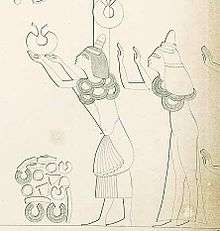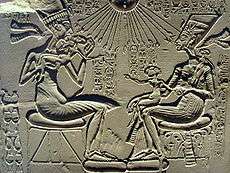Tey
| Tey | ||||||
|---|---|---|---|---|---|---|
| Queen consort of Egypt, Great Royal Wife | ||||||
 Queen Tey as depicted at the chapel at Akhmim (From Lepsius, Denkmäler) | ||||||
| Spouse | Pharaoh Ay | |||||
| ||||||
| Egyptian name |
| |||||
| Dynasty | 18th of Egypt | |||||
| Religion | Ancient Egyptian religion | |||||
Tey was the wife of Kheperkheprure Ay (occasionally "Aya"), who was the penultimate pharaoh of Ancient Egypt's 18th dynasty. She was also the wet nurse of Queen Nefertiti.[1]
Her husband, Ay filled an important role in the courts of several pharaohs – Amenhotep III, Akhenaten and Tutankhamen – before ascending the throne himself, as the male line of the royal family became extinct. He is believed to be connected to the royal family; he was probably a brother of Queen Tiye (wife of Amenhotep III).
Family
On inscriptions from the Amarna period, Tey is called “nurse of the Great Royal Wife”. This indicates that even if Ay was Nefertiti's father, Tey was not her mother; according to this theory, she was possibly the second wife of Ay after Nefertiti's mother died.[2] However, Ay and his wife Tiy are never called the father and mother of Nefertiti and Tey's only connection with Nefertiti was that she was the 'nurse of the great queen' Nefertiti which must mean that Ay was not Nefertiti's father.[3] It has been proposed that Mutbenret was Ay and Tey's daughter who later married Horemheb, Ay's successor on the throne.[4] However the name Mutbenret and Mutnedjmet, Horemheb's queen are not identical which implies that these 2 different women. It is also possible that Ay's intended successor, Nakhtmin, was his son, possibly by Tey.[5]
Tey may have had a sister called Mutemnub. A dignitary named Ay is called second priest of Amun, high priest of Mut and Steward of Queen Tey on a statue now in the Brooklyn Museum. This man's parents are recorded on the statue as Mutemnub and Nakhtmin. Mutemnub is said to be a sister of Queen Tey, and the inscription is usually interpreted to mean that she was the sister of Tey, wife of Ay.[6]
Amarna

Tey is depicted in her husband's unused Amarna tomb.[1] On the North Wall, East Side a reward scene is depicted. Aye and Tey are shown before the window of appearances. Akhenaten is shown in a Khepresh crown and Nefertiti in her well-known blue crown (in this case decorated with three uraei). Meritaten, Meketaten and Ankhesenpaaten are shown in the window of appearances as well. The eldest two seem to be throwing rewards to Aye and Tey, while Ankhesenpaaten stands on the pillow before Nefertiti and is caressing her chin.[7]
Tey is also mentioned on a wooden box. The box is inscribed for The true scribe of the king whom he loves, troop commander, overseer of cavalry, and Father of the God, Ay. And the text mentions: The much-valued one, the sole one (unique) of Re, appreciated by the Great Royal Wife, the mistress of the house, Tiy.[8]
Queen of Egypt

When Ay took the throne after the death of Tutankhamen, Tey became his Great Royal Wife. Queen Tey also held the titles Hereditary Princess (iryt-p`t), Great of Praises (wrt-hzwt), Lady of The Two Lands (nbt-t3wy), Great King’s Wife, his beloved (hmt-niswt-wrt meryt.f), and Mistress of Upper and Lower Egypt (hnwt-Shm’w T3-mhw).[9]
Queen Tey is depicted in the tomb of Ay (WV23) in the Valley of the Kings. She appears behind Ay in a scene where Ay appears to be pulling lotus flowers from a marsh. The images are rather severely damaged. Tey may have been buried with her husband in WV23, and fragments of female human bones found in the tomb may be Tey's.[10]
Tey is also depicted in a rock chapel dedicated to fertility god Min in Akhmim.[1]
References
- 1 2 3 Aidan Dodson & Dyan Hilton, The Complete Royal Families of Ancient Egypt, Thames & Hudson (2004) ISBN 0-500-05128-3, p.157
- ↑ Dodson & Hilton, pp.36,147
- ↑ Jacobus Van Dijk, Horemheb and the Struggle for the Throne of Tutankhamun, BACE 7 (1996), p.32
- ↑ Dodson & Hilton, pp.153, 155-156
- ↑ Dodson & Hilton, pp.151-153
- ↑ Dodson & Hilton, p.155
- ↑ Norman De Garis Davies, The rock tombs of el-Amarna, Parts V and VI: Part 5 Smaller tombs and boundary stelae & Part 6 Tombs of Parennefer, Tutu and Ay, Egypt Exploration Society (2004)
- ↑ Roeder, G.: Aegyptische Inschriften aus den Staatlichen Museen zu Berlin. - Bd.II - Leipzig: 1924. - p.267-268
- ↑ Grajetzki, Ancient Egyptian Queens: a hieroglyphic dictionary, Golden House Publications. p.63-64
- ↑ J. Tyldesley, Chronicle of the Queens of Egypt, 2006, Thames & Hudson
External links
| Wikimedia Commons has media related to Tey. |
| ||||||||||||||||||||||||||||||
